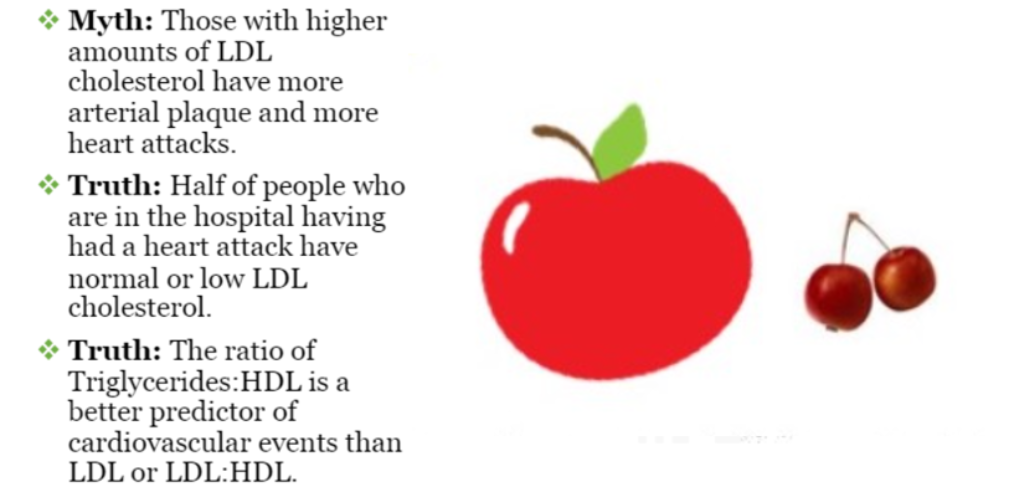
LDL Myths and Truths
LDL myths abound, but what are the LDL truths you need to know? First let’s discuss what this substance is.
What is LDL?
The first LDL myth is that it is a type of cholesterol. LDL, or low-density lipoprotein, is actually a carrier of cholesterol. Physicians use it as way of estimating cholesterol in the body because it represents the total cholesterol being transported from the liver to the rest of the body.
Here is the truth: LDL is essential to health because it is the one resource to deliver cholesterol to tissues for healing and repair. Cholesterol, as part of your immune system, becomes a kind of internal scab wherever there is tissue damage.
But cholesterol not only repairs tissue. It helps create the outer membrane of every cell in the body. Cholesterol is also the raw material for sex hormones.
Your body makes cholesterol in the liver abundantly! (Diet only accounts for 25% or less of your total cholesterol.) But if your LDL is too low, you cannot get that cholesterol to the cells for membrane synthesis or repair. Also, without LDL to move cholesterol from the liver to your gonads, you could not generate sex hormones.
What is LDL’s significance?
If LDL is so vital, then why do doctors become concerned when it rises? LDL is like water on a fire. If your LDL is high, it may be indicator of great oxidative damage in your body. Ask yourself this. Who needs more water: a person cooking dinner, or a person whose house is burning down?
So, LDL is a red flag. But there is an assumption (LDL myth #2) that the higher your LDL, the greater your risk of cardiovascular disease. In reality, research shows that total amount of LDL does not correlate well with incidence of cardiovascular disease. What seems to matter more is the type of LDL particles, rather than the overall number.
LDL is like a bag of apples. You want a sack of big, healthy apples, not a sack of little, insidious crab apples. The truth is that small, dense LDL – like crab apples – can be included in arterial plaque. This is known as pattern B LDL. It is more atherogenic, meaning it tends to promote fatty plaques in the arteries. Light & fluffy LDL, called pattern A, is less atherogenic because it is too large to be incorporated into arterial plaques.
Cardio IQ is one test that can evaluate the particle size of your LDL.
It is fiction that LDL is the only marker to be concerned about when it comes to heart health (LDL myth #3). LDL typically only becomes a red flag when your arteries are inflamed and attracting an immune response. Conditions that raise this flag include pre-diabetes, diabetes, chronic simmering infections, and toxicity.
Looking beyond LDL myths to other factors
HDLs (high-density lipoproteins) & triglycerides are extremely important disease markers, especially among women. In fact, if you are female, the more your triglyceride to HDL ratio rises above 2:1, the greater your cardiovascular disease risk. Besides that, high triglyceride to HDL ratios tend to correlate with Pattern B (small and dense) LDL’s.
HDLs are protective against atherosclerosis and are optimal at 65-85 mg/dL for women. Low levels may be an independent risk factor for atherosclerosis.
You can increase your HDLs with exercise, omega 3 fatty acids, and a low-carb diet. On the other hand, high-sugar intake, a high-carb diet, trans-fats, high fructose corn syrup, and smoking decrease HDLs.
If your doctor is concerned about plaque deposits, ask what damage your body might be trying to repair. What conditions might be causing enough oxidative damage that LDL is being transported at a higher rate?
Why LDL may be elevated
You might suppose that your LDLs are high because you have too much fat in your diet (LDL myth #4). There are actually several primary reasons why LDLs rise, particularly in women. These are:
• High blood sugars. Since high blood sugars create oxidize blood vessels, it is not surprising that LDLs increase to bring cholesterol to patch up these sites. This is why high LDLs can be a red flag for pre-diabetes and diabetes. So, the reality is that sugar, not fat, has a greater impact on blood lipids.
• Hypothyroidism. Elevated LDL where there is poor thyroid function is common, especially in women. Studies consistently demonstrate elevated levels of total cholesterol and LDL in individuals with hypothyroidism according to this review. If your triglycerides are low, but your LDL is high, you can suspect hypothyroidism is at play.
• Chronic stress. First of all, stress can increase blood sugars more than food can. By this mechanism, stress can increase LDLs. But there’s more. Stress also increases cortisol. Since cholesterol rises with cortisol, it makes sense that more LDL would be needed to transport that cholesterol. Finally, stress promotes hypothyroidism. So, stress increases LDL via low thyroid function.
• Estrogen dominance: Estrogen causes hypersecretion of cholesterol into bile. Since your body recycles 95% of its bile, this means you have higher serum levels of total cholesterol and cholesterol-transporting LDL.
Treating the truth, not the LDL myth
Here is another LDL myth: If you have high LDL, you should always be prescribed a statin.
The obvious answer to elevated LDLs is to address the root issue (blood sugars, hypothyroidism, chronic stress, etc.). It is true that statins reduce LDL cholesterol, but they are toxic to your cellular energy factories, the mitochondria. Statins are capable of preventing you from making coQ10, vital to energy production.
If you need help keeping LDL in check while you work on root causes, you can take a supplement that helps bind LDL away from bile in the GI tract before it gets recycled. One such supplement is CholestePure Plus II, a non-soy blend of phytosterols with berberine for healthy lipid function.
As always, work with a qualified practitioner to address your root causes.
